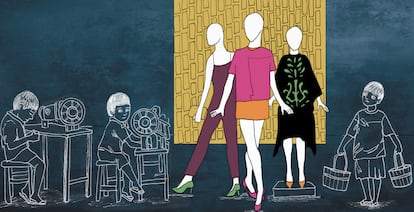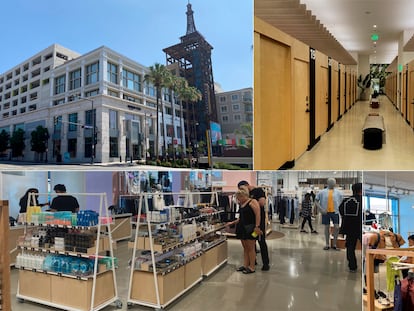An ‘anti-fashion’ manifesto: where does your clothing come from?
A guide for breaking the complicit silence that has flooded our closet with garments that are also major pollutants

What are the clothes you are wearing today made of? Where do they come from? Who made them? How much did the people who sewed them get paid? How many liters of water were used to make them? How long will they last in your closet? We have to ask questions about our clothes. We must break the complicit silence that has flooded our closets with cheap, anodyne, highly pollutant pieces. Turning a blind eye has made us feel less guilty, but the lack of guilt does not exempt us from responsibility.
Making an item of clothing like a T-shirt requires 2,700 liters of water, the same amount that a person would drink in 900 days. The garment was designed, cut, dyed and sewn by different people who live far away from where the shirt is ultimately sold. How is it that the shirt costs the same as a sandwich?
The pollution caused by the fashion industry is second only to the automotive industry. It accounts for 10% of global carbon emissions, stemming from the energy used in production, manufacture, and transportation.
Washing clothing releases 500,000 tons of microfibers into the ocean. Each year, 85% of the textiles produced end up in landfills. Burning past seasons’ products is a very common technique in the world of expensive fashion. Luxury brands have burned unsold products worth over $30 million simply to avoid putting them on sale and prevent their symbolic value from decreasing.

We need to slow down our clothing consumption! We must pare down our closets and ask ourselves uncomfortable questions that prompt us to engage in different consumption practices: Do I really need another pair of jeans? What is behind the desire to buy something new? Long ago, fashion ceased to be just about buying and selling clothes; it has become a huge market of identities. And it seems that identity is also in crisis: on average, people bought 60% more clothes in 2014 than they did in 2000.
We have to buy less and think differently about buying clothing.
For example, we have to understand what it is about the jacket that—despite the passage of time, wear and tear, and changing trends—has remained in our closet, unscathed, and is still a favorite. The fashion industry has to be more intentional about making well-loved, long-wearing clothing, “rather than quickly becoming emotionally redundant and easily replaced,” as Tamzin Rollason of the Center for Urban Research, aptly described it. Long, extended use of clothing is one of the most decisive ways to achieve less environmentally disastrous fashion.
We should dedicate ourselves to swapping clothing more, to buying used clothes that someone else no longer wears. We should devote ourselves to repairing and transforming the dresses or pants that we do not wear, or that have been damaged but could be turned into something else. The only truly sustainable fashion is clothing made without using any new materials.
Buying secondhand clothes should not be the exclusive act of people who love vintage clothing. It should become a normalized, ethical, and cool practice for everyone. It is a mandate to give new life to the glut of garments that flood our society and end up in huge landfills!
We also need more people to learn to make their own clothes. Through this do-it-yourself, custom-made commitment, we can and must challenge fashion’s tyrannical production system as well as its sizing scheme, which makes it increasingly difficult to love our bodies as they are. Making our own clothing is a way to be certain of our garments’ origins. It would help break the chain of poorly paid labor that comes along with the clothing produced in China. Doing this would also restore the body’s virtue of roundness and flesh. A dress must conform to the body, the body should not need to be forced to fit into a dress.
We should take a page from the movies, where even the most unremarkable character appears listed in the credits. Clothes should adopt a similar system in which the “credits” (labels) recognize everyone who had a hand in creating the garment. Then, when we ask who made it, we can learn about the people who crafted, cut, and sewed it. Perhaps with so many names and lives associated with an item of clothing, we will stop viewing clothes as disposable and instead begin to appreciate them as something valuable that deserves to be honored.
We must ask questions about our new clothes, our closets, and our old garments. In so doing, we can find ways to prevent our desire for nice clothing from abetting a real catastrophe.
Tu suscripción se está usando en otro dispositivo
¿Quieres añadir otro usuario a tu suscripción?
Si continúas leyendo en este dispositivo, no se podrá leer en el otro.
FlechaTu suscripción se está usando en otro dispositivo y solo puedes acceder a EL PAÍS desde un dispositivo a la vez.
Si quieres compartir tu cuenta, cambia tu suscripción a la modalidad Premium, así podrás añadir otro usuario. Cada uno accederá con su propia cuenta de email, lo que os permitirá personalizar vuestra experiencia en EL PAÍS.
¿Tienes una suscripción de empresa? Accede aquí para contratar más cuentas.
En el caso de no saber quién está usando tu cuenta, te recomendamos cambiar tu contraseña aquí.
Si decides continuar compartiendo tu cuenta, este mensaje se mostrará en tu dispositivo y en el de la otra persona que está usando tu cuenta de forma indefinida, afectando a tu experiencia de lectura. Puedes consultar aquí los términos y condiciones de la suscripción digital.
More information
Últimas noticias
Most viewed
- Sinaloa Cartel war is taking its toll on Los Chapitos
- Oona Chaplin: ‘I told James Cameron that I was living in a treehouse and starting a permaculture project with a friend’
- Reinhard Genzel, Nobel laureate in physics: ‘One-minute videos will never give you the truth’
- Why the price of coffee has skyrocketed: from Brazilian plantations to specialty coffee houses
- Silver prices are going crazy: This is what’s fueling the rally










































